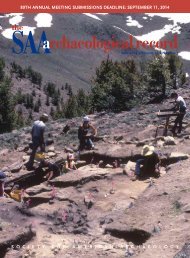SAA
Nov2016_web
Nov2016_web
Create successful ePaper yourself
Turn your PDF publications into a flip-book with our unique Google optimized e-Paper software.
VIDEO GAMES AND ARCHAEOLOGY<br />
ARCHAEOLOGICAL WALKING SIMULATORS<br />
Edward González-Tennant<br />
Edward González-Tennant is the lead digital archaeologist at Digital Heritage Interactive LLC.<br />
This article discusses how the ongoing experimentation<br />
with 3D technologies for archaeology can benefit from<br />
a deeper engagement with developing trends within<br />
video games. I am particularly interested in the recent<br />
growth of a specific genre of video games referred to as walking<br />
simulators. While initially used in a pejorative sense to<br />
describe boring games, this term now refers to a rapidly<br />
expanding category of video games that diverge from traditional<br />
ones through a reliance on evocative treatments of<br />
mature themes. Whereas traditional games rely on linear<br />
narratives of the human experience, walking simulators<br />
encourage meaningful exploration of rich worlds. They allow<br />
users to experience the lives and worlds of others in new and<br />
critically informed ways.<br />
My discussion of this intersection begins with an overview of<br />
the core aspects of walking simulators. I then discuss how<br />
the use of this technology supports the public’s awareness<br />
and appreciation of the African American experience in<br />
Florida. This interest in exploring walking simulators<br />
focuses on their potential for social justice, and I briefly<br />
describe ongoing work at the sites of Rosewood and Prospect<br />
Bluff. The article concludes with my thoughts on how this<br />
approach supports the goals of applied archaeology, by which<br />
I mean the process of drawing on archaeological data and<br />
perspectives to engage with modern social issues.<br />
A Primer on Walking Simulators<br />
Walking simulators represent a rapidly growing genre of<br />
video games, one that differs from traditional games in<br />
important ways. Whereas traditional video games have budgets<br />
and labor requirements rivaling those of major motion<br />
pictures, walking simulators are typically produced by independent<br />
game studios. Like independent film, indie games<br />
benefit from the increased availability of inexpensive computer<br />
hardware and high-speed Internet access. This is a part<br />
of the broader growth of new media, or the translation of traditional<br />
media into digital formats, which provides<br />
moviemakers and game developers alike an alternative to the<br />
industrial logic of traditional media (Manovich 2001).<br />
Although traditional games make use of new media, they<br />
also reproduce the earlier industrial logic of cinema by relying<br />
on large-scale studios, expensive equipment, and wellestablished<br />
narrative tropes. Walking simulators, like<br />
independent films and games alike, take advantage of new<br />
media’s postindustrial possibilities.<br />
One of the primary advantages of this new approach to video<br />
games is the ability to concentrate on narrative in new ways.<br />
A common complaint leveled against walking simulators is<br />
their lack of a linear narrative structure. However, for many<br />
this is precisely what draws them to these sorts of games. It<br />
is this type of experience that made Myst so popular in the<br />
1990s. Since walking simulators eschew common video<br />
game conventions such as combat, scorekeeping, and a clear<br />
win/lose system, they are able to produce a more lifelike<br />
experience wherein the player explores a new world without<br />
a scripted series of events. This is illustrated by the Fulbright<br />
Company’s game Gone Home, where players take on the role<br />
of Katie, a recent high school graduate returning home after<br />
a year of backpacking through Europe. Katie’s family has<br />
moved during her absence and she returns to an empty<br />
house. The goal of the game is to discover the whereabouts<br />
of Katie’s family. As players explore the home (Figure 1),<br />
clues are revealed explaining where Katie’s sister and parents<br />
have gone. The game refuses to use worn-out supernatural<br />
tropes to explain the family’s absence. Instead, its sensitive<br />
treatment of sexuality has been hailed by critics for its ability<br />
to “plumb the depths of experience outside of gaming’s typically<br />
targeted white, male, youthful core” (Braga 2013). This<br />
focus on new forms of storytelling within games means that<br />
walking simulators are capable of reaching new audiences by<br />
providing new experiences via a familiar technology.<br />
The experience of this new narrative style is deeply affecting<br />
November 2016 • The <strong>SAA</strong> Archaeological Record<br />
23




